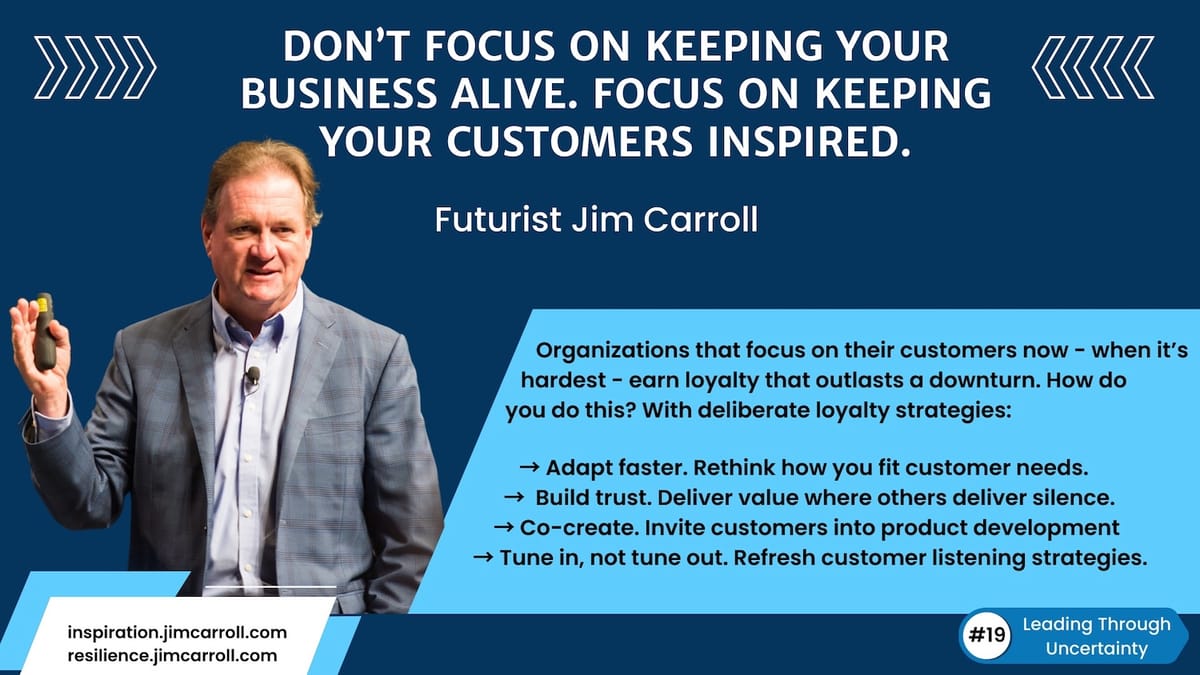"Don't focus on keeping your business alive. Focus on keeping your customers inspired." - Futurist Jim Carroll

In a downturn, you need to be customer-focused, not company-centered.
Crisis pulls you inward, but growth demands you look outward. And in a downturn, obsessing over evolving customer needs is how you find your next growth curve.
Look, when uncertainty strikes, it’s natural to look inward. Protect what you have. Defend your position. Hunker down and wait it out. But growth doesn’t come from within.
It comes from listening to the people you serve - your customers. In every downturn, the companies that come out stronger are those that never lose sight of one thing: customer behavior is changing faster than your business model. Economic volatility reshapes priorities:
- how customers spend
- what they value
- what they trust
- what they expect next
And in that shifting landscape lies your greatest opportunity—if you’re paying attention.
I have two memorable customer moments in the immediate aftermath of the 'Great Recession' of 2008. The first occurred when I spoke at a leadership event for the Compass Food Group. The CEO spoke about the downturn for just a few minutes - and then explained in detail how their strategy for the next many months was to be obsessively customer-focused. Talking to them, understanding their unique needs, how things were changing, and what the organization could do to serve them better. "We're going to focus on helping them get through this thing and that will get us through this thing" was his core message.
The second was at an event for the Readers Digest Food & Entertainment group in New York City - I had a room full of senior executives for food, consumer products, packaging, advertising, and other companies. After my my keynote, during the Q&A, one individual told the room that their business was stock photography as used in advertisements - and she commented that she was planning to upstate New York to take a bunch of photos of rural America, Why? Because she perceived that advertising messages focused on warmth and comfort would come to dominate - and she wanted to have material that would support that sort of message. Fun fact - she was right. After the recession, it was shown that Campbell Soup was one organization that saw significant revenue growth, because more people were cooking at home, and saw the brand as something that provided ..., as seen in its advertisements ... comfort and warmth.
The thing is - your customers were already changing before this moment, but now it accelerating. Customer behavior was undergoing a massive transformation:
- customers became less loyal and far more demanding.
- they expected instant support, frictionless service, and constant innovation.
- loyalty eroded fast—1 in 3 highly loyal customers in 2007 switched brands in 2008.st
- they're more informed—often knowing more than your frontline staff.
- they expect your brand to match the pace of a global innovation feedback loop.
- their attention spans are short, buying behavior erratic, and brand expectations sky-high.
- peer networks and reviews now outweigh traditional marketing as purchase drivers.
- demographics are shifting—Gen Z and Gen Alpha expect personalization, ethics, and purpose.
- values are evolving fast: transparency, sustainability, authenticity, and speed now define success.
The fact is, we now live in a time in which we have to build new relationships with customers because everything about the customer relationship has changed. Customers today can instantly go public on social networks with feedback and commentary on interactions with a company - and it's not always complimentary. They can instantly price compare through their mobile phones, rendering almost obsolete the concept of customer loyalty. They can band together in new and unique ways and 'swarm shop' through last-minute deal services, which can substantially cut into profit margins. And they can even render a brand-new product instantly obsolete if it doesn't match their expectations.
In this landscape, customer expectations don’t slow down during a downturn—they sharpen. That's because they are supersensitive to everything - price, quality, level of service. Their expectations of you go through the roof because it's their hard-earned money, and they want the best they can get!
In a downturn, companies don’t just survive because they “stay the course.” They redefine the course based on where the customer is headed. This means that right now, you need to be obsessively customer-focused., It's a moment to:
- tune in, not tune out. Refresh your customer listening strategies.
- adapt faster. Rethink what you offer and how it fits current needs.
- co-create. Invite customers into the product development and feedback loop.
- build trust. Deliver value where others deliver silence.
The organizations that center their customers now—when it’s hardest—earn loyalty that outlasts the downturn.
Because the best growth strategy in any economy is simple: Don’t focus on keeping your business alive.
Focus on keeping your customers inspired.
Your revenue will thank you for it.
Changing customer and consumer behavior has been the focus of many keynotes delivered by Futurist Jim Carroll through the years.

